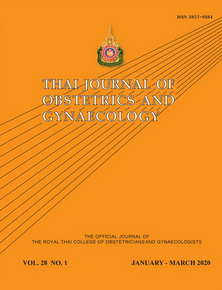Using Abdominal Binder for Reducing Postoperative Wound Pain After Cesarean Delivery: A randomized controlled trial
Main Article Content
Abstract
Objective: To determine the effect of using abdominal binder after cesarean delivery on postoperative wound pain, physical function and analgesic drugs use.
Materials and Methods: A randomized controlled trial was conducted between January and April 2018 at KhonKaen Hospital. Fifty women who underwent elective cesarean delivery were randomly allocated to either the abdominal binder group or routine standard care. The primary outcome was postoperative wound pain as measured by a visual analog scale (VAS) scores at 6, 24, and 48 hours after using the binder. The secondary outcomes included physical function as measured by distance 6-minute walk test (6MWT), time to first ambulation, analgesic drugs use and adverse effects.
Results: Postoperative wound pain was indicated by a significantly lower VAS score in the binder group with the repeated measures ANOVA (F= 30.78, p < 0.005). The respective postoperative VAS score at 6, 24, and 48 hours was also significantly lower in the binder group (mean ± SD at 6, 24, and 48 hr. = 4.77 ± 1.97, 3.73 ± 1.48, and 2.51 ± 1.63 vs. standard care 6.85 ± 2.26, 5.49 ± 2.34, and 4.66 ± 2.21; p < 0.05). Postoperative opioid drugs use in the binder group was significantly less than in the standard care (5.22 ± 1.20 mg vs. 7.63 ± 2.43 mg; p < 0.01). There were no significant differences in the 6MWT and time to first ambulation between the two groups. No serious adverse effects were reported.
Conclusion: Using abdominal binder can reduced pain and analgesic drugs used in postoperative cesarean delivery.
Article Details
References
2. Hanvoravongchai P, Letiendumrong J, Teerawattanonon Y, Tangcharoensathien V. Implications of private practice in public hospitals on the cesarean section rate in Thailand. Health Systems Research Institute, Thailand 1998.
3. Izveren OA, Dal U. The early period complications in the patients who were performed abdominal surgery intervention and the nursing practice for these complications. J Nurs Health Sci 2011:18:36-46.
4. Havey R, Herriman E, O’Brien D. Guarding the gut: early mobility after abdominal surgery. Crit Care Nurs Q 2013;36:63-72.
5. Ghana S, Hakimi S, MirghafourvandM ,Abbasalizadeh F, Behnampour N. Randomized controlled trial of abdominal binders for postoperative pain, distress and blood loss after cesarean delivery. Int J Gynaecol Obstet 2017;137:271-6.
6. Richardson J, Sabanathan S. Prevention of respiratory complications after abdominal surgery. Thorax 1997;52:S35-40.
7. Lavoie A, Toledo P. Multimodal postcesarean delivery analgesia. Clin Perinatol 2013;40:443-55.
8. Cavalho B, Cohen SE, Lipman SS, Andrea F, Andu D.M, Alex M. Patient preference for anesthesia outcomes associated with cesarean delivery. Anesth Analg 2005;101:1182-7.
9. Scultetus AH, Villavicencio JL, Rich NM. The life and work of the German physician Johannes Scultetus(1595-1645). J Am Coll Surg 2003;196:130-9.
10. Larson CM, Ratzer ER, Davis-Merritt D, Clark JR. The effect of abdominal binder on postoperative pulmonary function. Am Surg 2009;75:169-71.
11. Leblanc KA. Laparoscopic incisional and ventral hernia repair: complications-how to avoid and handle. Hernia 2004;8:323-31.
12. Mustafa G, Al Mamun A, Ahmad N, Alam S, Khan M, Alam K. Percutaneous liver biopsy: technique and safety. Hepatogastroenterology 2011;58:529-31.
13. Rothman JP, Gunnarsson U, Bigaard T. Abdominal binders may reduce pain and improve physical function after major abdominal surgery – a systematic review. Dan Med J 2014;61:41-9.
14. Giller CM, Sparks JR, Kriner R, Anasti JN.A randomized controlled trial of abdominal binders for management of postoperative pain and distress after cesarean delivery. Int J Gynaecol Obstet 2016;133:188-91.
15. Szender JB, Hall KL, Kost ER. A randomized clinical trial examining a neoprene abdominal binder in gynecologic surgery patient. Clin Exp Obstet Gynecol 2014;41:525-9.
16. Cheifetz O, Lucy SD, Overend TJ, Crowe J. The effect of abdominal support on functional outcomes in patients following major abdominal surgery: a randomized controlled trial. Physiother Can 2010;62:243-53.
17. Arici E, Tastan S, Can MF. The effect of using an abdominal binder on postoperative gastrointestinal function, mobilization, pulmonary function and pain in patients undergoing major abdominal surgery : A randomized controlled trial. Int J Nurs Stud 2016;62:108-17.


